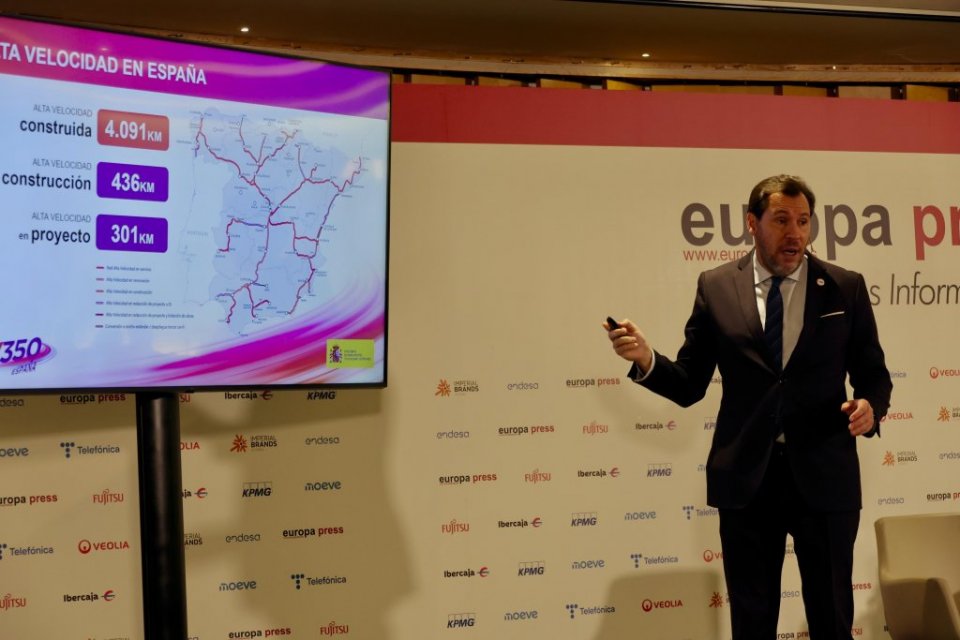Spain intends to bring the journey time on the AVE high-speed service between Madrid and Barcelona down to less than two hours, Transport Minister Óscar Puente (main image) said on Monday.
The cut in travel time will come as the trains’ top speed rises from 300 km/h to 350 km/h. According to Puente, upgrading the line will place Spain among the world’s fastest rail networks, rivalled only by China’s.
He pointed to the extraordinary growth in demand on this corridor to explain why it is being prioritised: annual use has climbed from two million passengers when the line opened to around 15 million today. Trains now account for 85% of all travel between the two cities.
Neither the budget nor the timeline for the works has been set out yet. However, the recently completed overhaul of the Madrid–Seville AVE – a three-year project costing roughly €750 million – is expected to serve as a benchmark.
A tender for upgrading the Madrid–Barcelona route was issued on 17 November. Puente noted that bringing the line up to 350 km/h will not require major additional investment, since the infrastructure is already designed for that speed.
The minister added that the improved timetable will be phased in: each section will be fitted with new sleepers as soon as it is refurbished, allowing trains to begin running faster without waiting for the entire line to be finished. Over the three years of works, journey times will gradually shrink until the promised sub-two-hour mark is reached.
Given the route’s heavy congestion, Puente said the ministry faced a choice: to ‘increase the speed of the trains or double or triple the number of tracks’. He argued that raising speeds is the better alternative, as it shortens journeys while reducing the amount of time each train occupies the tracks.
The project also foresees a new high-speed station in Parla, south of Madrid, allowing passengers travelling between Andalusia and Barcelona to bypass Atocha and Chamartín in central Madrid. Puente also mentioned a future direct link between Madrid Chamartín and Barcelona that will avoid routing services via Atocha.
In practical terms, the Parla station will serve more than one million people in the town and its surrounding municipalities. It will also become a new stop for services connecting Valencia, Alicante, Murcia, Seville and Malaga with Madrid.
Situated close to the Parla Norte Cercanías station, it will be the Madrid region’s fourth high-speed hub. Chamartín and Atocha are already operational, and the Barajas Terminal 4 station is due to open soon.
Subscribe to the Weekly Newsletter from Spain in English.
El ministro @oscar_puente_ anuncia actuaciones para aumentar a 350 km/h la red de Alta Velocidad.
— Ministerio Transportes y Movilidad Sostenible (@transportesgob) November 17, 2025
“Vamos a ser el único país del mundo junto con China”.
Además, en España tenemos la red de Alta Velocidad con el coste por km más bajo del mundo.
🗞️ https://t.co/u2mLg6RAUM pic.twitter.com/kjprFq3Fvr
El Diario Oficial de la Unión Europea publica esta mañana la licitación de los estudios que permitirán aumentar a 350 km/h la alta velocidad entre Madrid y Barcelona y reducir a menos de dos horas el trayecto.
— Óscar Puente (@oscar_puente_) November 18, 2025
Ayer lo anunciamos y hoy ya está en marcha. https://t.co/c8NUuLOxrc https://t.co/Tqfxb8lUkY pic.twitter.com/WKLvrvu8Xo
Click here to get your business activity or services listed on our DIRECTORY.


